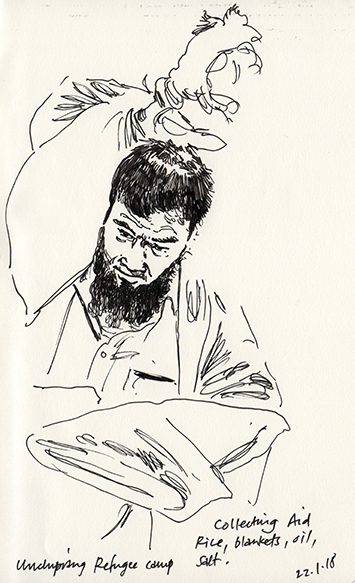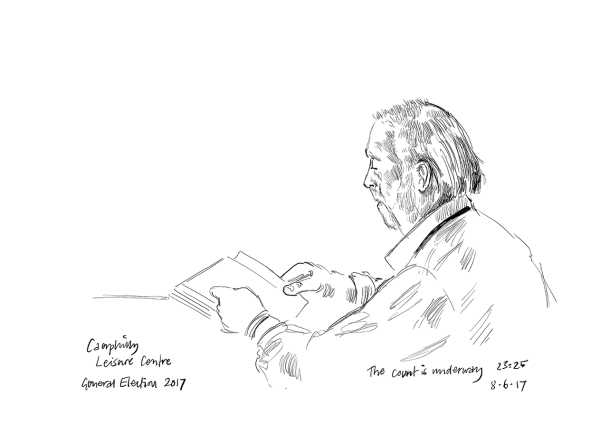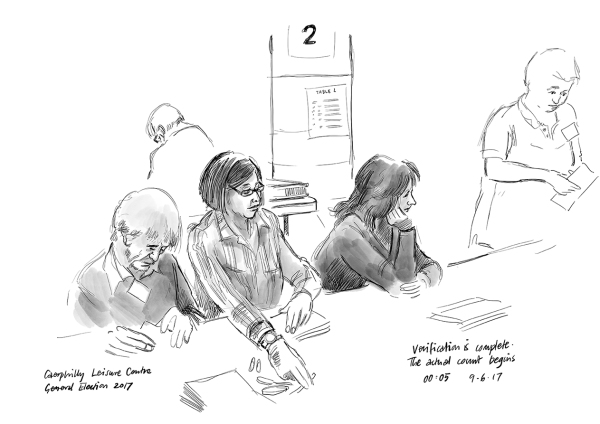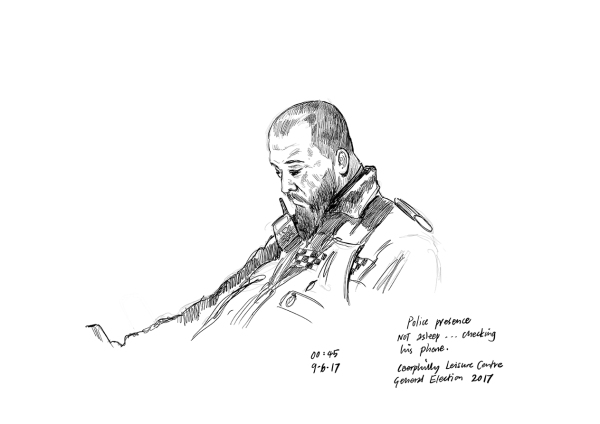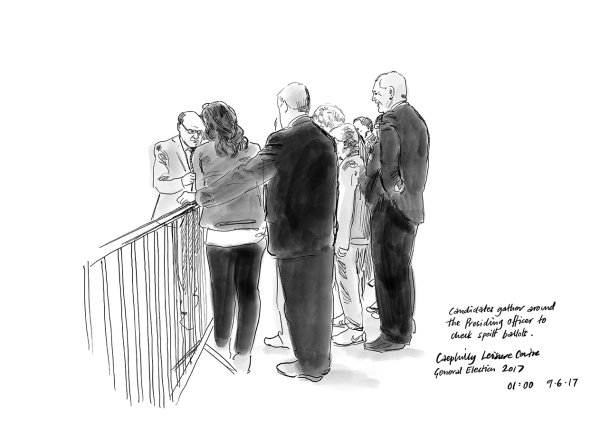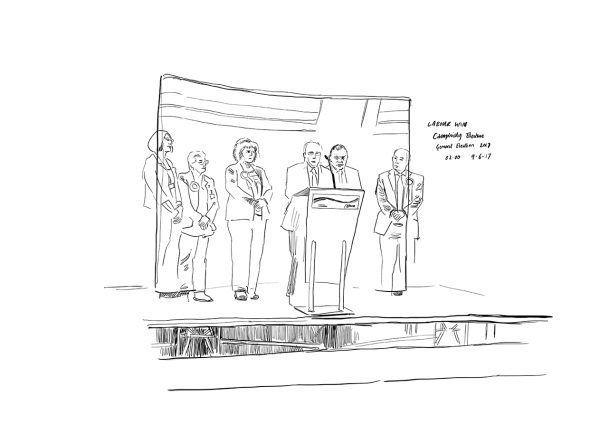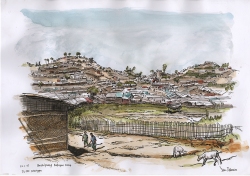
I spent the last few weeks of January in Bangladesh. The first week was spent in the North of the country in a region called Sylhet. I was there to draw pictures of a British Council funded project called “Connecting Classrooms” which saw a group of teachers from Cardiff and the South Wales Valleys visiting and teaching in schools around the region. I will write a post about that part of the trip at a later date.
The second part of the trip was an eleven hour train journey followed by a four hour car drive which took me from Sylhet to Cox’s Bazar via Chittagong. Then on from Cox’s Bazar along the Kolatoli beach, at 155km long, the longest unbroken beach in the world, for about 50km to the Unchiprang Refugee Camp. The camp is fairly new and home to some 24,000 refugees who have made the journey to Bangladesh from Myanmar to escape the “ethnic cleansing” being perpetrated upon them by the Myanmar military and, allegedly, groups of Buddhist civilians.
I was in the company of a group of British people from the Bangladesh Association Cardiff, who I have been working with over the last few months on 2017, to help raise money for the refugees. This visit coincided with the delivery of £40,000 worth of aid supplied by the Association and paid for by the people of South Wales who donated much of the money by visiting their local restaurants and takeaways who then donated their profits.
When we first arrived at the camps we stopped to register with the authorities and found ourselves next to a Malaysian filed hospital. It was early and I met the first Rohingya’s of the trip. They were queueing outside the hospital. A number of them had only just been registered and, on seeing me, were keen to show me their registration cards. They were kind enough to let me draw their pictures, although the little Rohingya lady found the experience rather overwhelming and slipped away through the crowd that had gathered while I was drawing her.
We moved on from there driving for maybe 45 mins. There was no break in the hills covered with refugee camps. Shelters made of bamboo and tarpaulin sheets with the odd official NGO (Non Government Organisation) tent amoung them. It was during this drive that the scale of the situation became painfully apparent. There are, officially, over 800,000 Rohingya refugees in Bangladesh with locals telling me it is over a million in reality. They are all living in these temporary shelters, crammed together with no sanitation and little food. They have used all the trees from the surrounding hillsides to make fires for warmth and cooking and the bamboo to make their shelters.
When we arrived in Unchiprang we drove into a paved courtyard that sits at the centre of the camps distribution centre. A meeting was in progress in a covered area at one end of the courtyard. On either side ran covered bamboo fenced queueing areas, much like at a football ground or festival site, where refugees were beginning to gather. It was the daily briefing, apparently, where NGO’s and volunteers discuss with the local Army the coming events for the day. We met Paul Chamberlain, Logistics Director for a charity called MOAS. He told us they originally came to Bangladesh to assist with water borne refugees who were making their way from Myanmar to Bangladesh across a stretch of water between there two countries. The charity had originally been set up in Italy and were among the first to assist migrants and refugees attempting the crossing of the Mediterranean. It became quickly apparent that they were needed on the land more and so have set up a number of aid centres, mainly medical, in the camps, and that Unchiprang was the location of one of those. He explained that currently their biggest concern was the impending monsoon season, only a couple of months away, which was likely to bring flash floods and mudslides due to the deforestation I described earlier.
I stood at the end of the paved area and began drawing the camp that lay across a dry, muddy, field and stretched out across the rolling hills as far as the eye could see. The roofs of shelters shone out, reflecting the harsh midday sun. It’s the middle of winter in Bangladesh but the temperature was still in the high twenties. A group of children soon gathered round and I got into conversation with a student who had simply come to observe and see the refugee crisis for himself. He was keen to talk to me and practice his english. I recorded the conversation as I had the conversation with Paul Chamberlain earlier as I was gathering sound for BBC Radio and online reports. Must have been quite a sight, drawing board proped up on a fence, pen in one hand sketching and recorder in the other with a lead trailing to an earphone in one ear.
As I drew the sound of big diesel engines came from down the dusty track which had brought us to the camp and which ran between the camp on one side and a makeshift bazar on the other. Typical bangladesh market stalls with fresh fruit, sweets and biscuits and even a barber shop. The trucks came into view as they drove further along the track, past the medical centre and various aid stations situated on the camp side of the road and on to where I was standing by the distribution centre. They reversed, one at a time, alongside one of the sheltered queues to the left of the courtyard. There was a period of increased activity as the trucks were unloaded into holding pens that were positioned to the side and behind the meeting area.
Children and adults alike waited in their queues on either side of the courtyard. They didn’t have to wait much longer. As the children tucked into a hot meal paid for from the South Wales fund and prepared for them on site, the green tabard wearing men of the Bangladesh Association Cardiff worked with the local aid workers to distribute food parcels and cleansing kits to the refugees.
We had been brought to Unchiprang by retired Major Sayesta Kahn. Sayesta is Operations Director for Best Western Heritage hotels in Cox’s Bazar. He has personally paid for the construction of a school and orphanage, medical centre and distribution centre at Unchinprang camp. He works as coordinator for the camp and supervises the military personnel as well as the NOGs and volunteers who run the camp. He took me to see the school and orphanage. Effectively a set of tents some 400 metres or so further along the track. As we approached I could see water tanks with pipes running from them to a set of taps set into a concrete hard standing by the side of the road. Children were drinking from the taps. The school is made up of about 4 or 5 large marquee style tents with rugs on the floor and a board at one end. The orphanage is a group military green tents fitted with solar lights and filled with sleeping bags and mats. A row of chemical toilets runs behind and a dusty play area to one side with a volleyball / badminton net set up in the middle of it. “Major” tells me he has some 400 children in the school and 108 orphans. “Major” is currently having a set of classrooms built next to the water tanks where he says the children will eventually be able to access distance learning provided by teachers from Dhaka. There were not a lot of children at the school as they had gone for food but “Major” introduced me to one little orphan boy called Fahim.
Fahim told me his story with “Major” acting as translator. When the Myanmar Army and Buddhist’s came to his home he had run to hide in the jungle. He watched as his parents and younger sister were slaughtered and then as his home and family were destroyed by fire. He ran further into the jungle until he came across a group of Rohingya’s who he then followed to the border. They spent time in ‘no-man’s land between the two countries until the Bangladesh military allowed them to cross into Bangladesh. He was found crying on the side of the road and picked up by some Bangladesh soldiers who brought him straight to “Major”. He now lives in the orphanage and appears to be inseparable from “Major” whenever he is at the school.
Before leaving the camp I was shown around the medical centre / hospital that “Major” has set up and is run by Army medics from the Bangladesh Medical Corp. I met there another refugee, a man who was helping in the medical centre and who had escaped with his family when the soldiers came and burned down their house and farm.
We visited the camp again the next day and spent time with the children in the school and delivered medicines to the hospital.
External Links:
Here is a link to the audio I gathered and which was edited by the BBC for broadcast on BBC Radio Wales on Monday 30th April 2018: Fast forward to 1:52 approx.
https://www.bbc.co.uk/programmes/b0b0scz1
Here is a link to social media content produced using the audio and the illustrations I provided to the BBC:
Fund Raising:
Here is a link to the fundraising page I have set up to try and raise more money for the refugees, specifically at Unchiprang camp. I will make sure the money goes directly to the camp administrator.
https://www.justgiving.com/crowdfunding/rohingya-relief-buef-dan-peterson
Sketch by Vivian Aldridge 2017
The Phoebe A. Hearst Museum of Anthropology at the University of California in Berkeley is hosting a show, “This is What Democracy Looks Like” with the SF Bay Area Urban Sketchers. These drawings chronicle resistance and demonstrations from the local (Bay Area, New York, Oregon) to the global (Turkey, Wales). The sketches, like the events themselves, are part of a worldwide effort to highlight community engagement in social and political action. Sketchers featured include Vivian Aldridge, Pedro Fernandes, Veronica Lawlor, Cathy McAuliffe, Dan Peterson, Rita Sabler, and Samantha Szaza.
The mission of Urban Sketchers is to raise the artistic, storytelling and educational value of location drawing, promoting its practice and connecting people around the world. With a small sketchbook, pencil or pen, sketchers “see the world one drawing at a time.”
The show runs from February 15 to March 30, 2018. The Phoebe A. Hearst Museum of Anthropology is located in 102 Kroeber Hall on Bancroft Way at College Avenue on the campus of the University of California, Berkeley. The Museum entrance is located through the courtyard, on the southern side of the building. For more information please visit www.urbansketchers-bayarea.blogspot.com and www.hearstmuseum.berkeley.edu/exhibit/democracy .
We want to express our appreciation to both Blick Art Materials and Flax Art & Design in Oakland for their support.
The drawings I made that are part of the exhibition:
Maindy Barracks, Cardiff – from the inside
A sketch I made over a couple of days while working in Maindy Barracks, Cardiff.
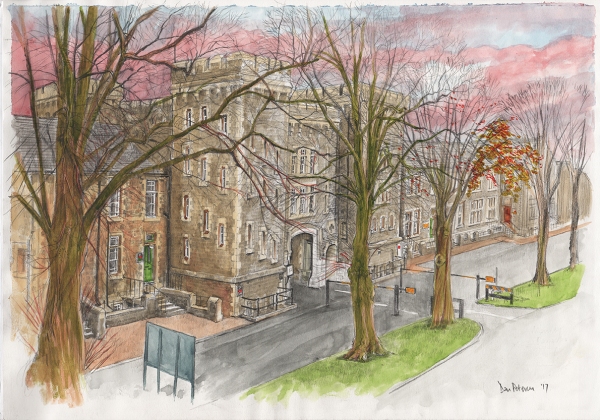
Cartoon Christmas commission

Snails Deli Rhiwbina
Some sketches made in Snails Deli over the last few months.


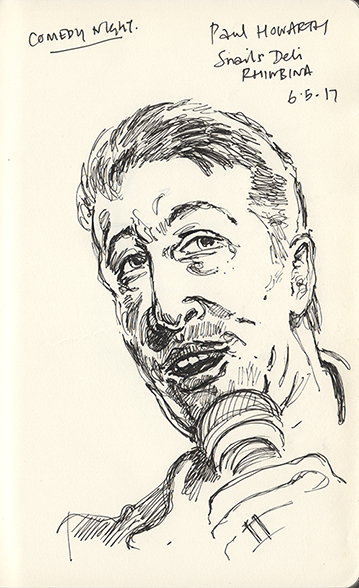
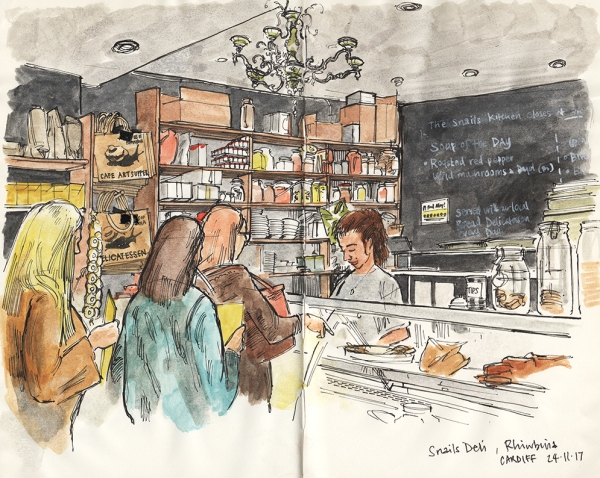
A trip to the Glee Comedy Club
Set of portraits – five children from the same family
Rudry Music Festival
iPad illustration. Manchester bombing story
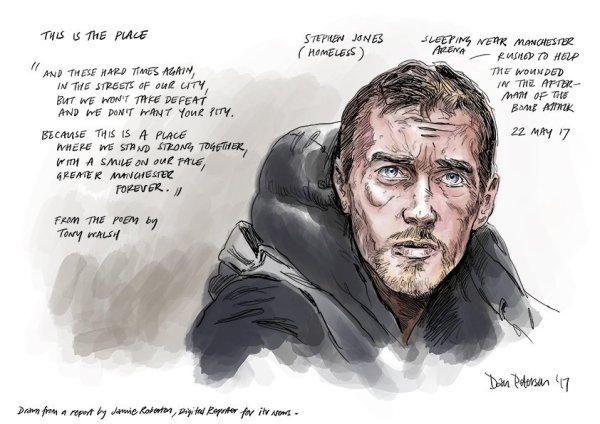
UK General Election 2017
Only a couple of months ago, I was drawing pictures of the UK Local Council Elections. This week I’ve been drawing pictures at a count for a UK General Election.
Just back in March 2017 Prime Minister Theresa May said she would not call a General Election until 2020. Then, almost out of nowhere on April 18th, she declared she was calling a ‘snap’ election as it was the only way to “guarantee certainty and stability for the years ahead” – precisely the same reason she had given for why she would not call an election until 2020. Her election slogan became “Strong and stable government”.
For the last seven weeks we’ve watched Theresa May and the Conservative Party go from predictions of an overwhelming majority win to a very exciting and close contest which resulted in a minority win for them, eight seats short of a majority in the House of Commons. With Jeremy Corbyn, the person they claimed as a weak and incapable leader, who had only recently faced a challenge to his leadership of the Labour Party, ride an ever increasing wave of popularity as he went from town to town spreading his message of a Government “For the many, not the few”.
We now find ourselves with a Hung Parliament and the Conservatives holding negotiations with the Northern Irish DUP, Democratic Unionist Party, who won 10 seats in the election, in an attempt to form a majority government. Who knows how things will develop with many calling for May’s resignation and others claiming we’ll see another General Election before the year is out.
All that aside I managed to get myself into one of the election counts on the Thursday night, 8th June and on into the hours of Friday morning. This was not as easy as it was for the Local Council Elections. I have been working with the BBC leading up to the election and they tried to get me into the main Cardiff count but without success as there are time limits to media accreditation. Actually, being accredited media would not have worked so well as the media are not allowed into the actual count area. It would have been hard to get the close observations I prefer. As it turned out a friend of mine managed to get me in as a Liberal Democrat Party observer in the Caerphilly count. Caerphilly is a town just north of Cardiff.
The work I’ve been doing with the BBC was connected with trying to find ways to increase awareness and participation with politics and the General Election. I produced sketches and illustrations to accompany online pieces under the project heading “My Manifesto”. Members of the public were asked to submit suggestions stating what they would do if they were Prime Minister. Some of these people were then interviewed and their story and manifesto suggestions put on television and online.
In one case I was lucky enough to accompany the crew as they were ‘gathering’ the story. During those few hours I managed to make some live sketches. The first one shows a woman from a place called Butetown (originally known as Tiger Bay) in Cardiff who was concerned about the rise of race related crime and behaviour since the Referendum on the UK leaving the European Union (EU), where the vote went in the favour of leaving the EU.
These drawings are made on a largeApple iPad Pro that the BBC loaned me for the duration of the project. I’ve tried tablets of one kind or another over the years but never been very impressed. The latest iPad Pro using an application called ProCreate proved to be irritatingly good. I say irritating in that my preference has always been for pen and paper, if only because there is effectively no original with equipment like this.
The BBC and myself made the decision to try the iPad as ProCreate offers a time-lapse recording of the drawings you make on it which added an element of animation and movement to the work which we felt important due to the video nature of the pieces we were producing. I was strict with myself in that I did not use the ‘undo’ feature at any time and stuck with a pen option and a watercolour brush as I would have had I been using my usual, more traditional, equipment. The sketch of Gaynor Legal I made in three stages. The portrait element during the interview process and the buildings after they had finished the interview. To be accurate with the things Gaynor was saying I recorded her interview on my phone and then annotated the sketch at the end. Just an issue of timing really.
The other live sketches I made were done during other interviews that took place on the same day. They were of Jenny Rees, a BBC journalist and Gwion Jones, a cameraman as they interviewed the people of Butetown.
So, back to the day of the election. Prior to the count came the voting of course. As I was in the mode of trying to generate interest in politics and the election using drawing I made a couple while I was making my own vote. These two were done in my sketch pad with a real ink filled pen rather than the very clever, if electronic Apple Pencil. I made them outside, and with permission, inside my local Polling Station in the north of Cardiff.
The following sketches were all made during the count in the Caerphilly Leisure Centre. The layout within the hall has a stage at one end where the TV cameras and press can film and record the result. Then about three quarters of the hall is fenced off. Only those involved with the counting, candidates, agents and observers are allowed in this area. It is split up again with fences stopping everyone other than counters entering the centre. Candidates, agents and observers (me) can observe from a fenced off area on either side of the central count area. The central count area is filled with tables, each one numbered and assigned specific elements of the counting.
In the first instance the ballot papers are simply counted to make sure they match the records taken at the polling stations – that is that there are the quantities they are expecting. Then the ballots are split into candidate piles and checked and then they are actually counted. At one point the candidates and agents are called forward to agree any spoilt papers. A spoilt ballot is one that has been left blank or one on which there has been more than one vote made or marked in such as way as to invalidate it, such as putting a line through it and writing ‘none of the above’.
At the end of the count the candidates are called together and advised of how close the result is giving them a chance to challenge it and ask for a re-count. If no re-count is requested they go onto the stage and the Presiding Officer announces the results.








